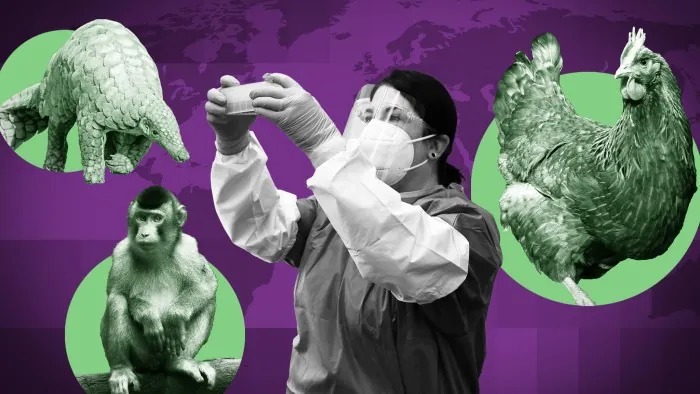
The Alarming Rise of Zoonotic Diseases: Is Our Next Pandemic Lurking Among Animals?
2025-01-10
Author: Arjun
The Urgent Need for Surveillance and Prevention
In the heart of Thailand's Khao Yai National Park, a sedated macaque lies on the back of a pickup truck, its blood and tissue being sampled by veterinarians on a mission to uncover potential pathogens that could trigger the next pandemic. This seemingly minor act is part of a larger, critical global effort aimed at predicting and preventing new infectious diseases that can jump from animals to humans.
Field virologist Supaporn Wacharapluesadee emphasizes the importance of this work for human health, stating, “Even though we are dealing with wildlife, our work is for human beings.” The search for "Disease X," a term used to indicate an unknown pathogen capable of causing widespread illness, has never been more urgent. Many experts agree that such a pathogen is likely to have zoonotic origins, exacerbated by recent alarming outbreaks, including the recent deadly bird flu incidence in the U.S. that has now resulted in human fatalities.
The Threat of Zoonotic Diseases
As the world grapples with the continuing fallout of COVID-19, zoonotic diseases—which can easily transition from animals to humans—represent a substantial threat to global health security. The World Health Organization's (WHO) Maria Van Kerkhove indicates that approximately 75% of newly emerging infectious pathogens are zoonotic, and climate change is exacerbating this risk as human encroachment into wildlife habitats often leads to increased interactions between humans and animals.
The past year has highlighted this dangerous trend with outbreaks of the Mpox virus in multiple African nations and a Marburg viral disease outbreak in Rwanda. Investigators and scientists, particularly the Coalition for Epidemic Preparedness Innovations (CEPI), are intensifying their efforts to understand and monitor these zoonotic threats, but knowledge gaps persist, especially in biodiverse regions with fewer resources.
Compounding Factors
As we assess the current landscape, the emergence of zoonotic diseases is further complicated by the growth of human activity that disrupts the delicate balance of ecosystems. Various factors, including urbanization, climate change, and agricultural practices, have resulted in increased contact between humans and previously isolated animal species. For instance, industrial farming has put livestock and wildlife in closer proximity than ever before, raising the stakes for potential disease transmission.
Potential Future Pandemics
The alarming possibilities of future pandemics are underscored by a recent study, suggesting that five existing zoonotic diseases could lead to a staggering 12-fold increase in human fatalities from 2020 to 2050. These include Ebola, Nipah virus, and variants of the coronavirus responsible for COVID-19.
Proactive Measures and Early Detection
Efforts to stanch the potential deluge of zoonotic diseases are rooted in early detection. Researchers call for a proactive approach, focusing on high-risk areas like wet markets, which are hotbeds for zoonotic spillovers. The latest technological advancements in genetic sequencing are proving invaluable in identifying pathogens before they can spread in human populations.
Innovative programs like those in Thailand, where international military collaborations are surveying livestock and wildlife, show promise. The U.S. Army, in partnership with Thai authorities, is strategically sampling animal populations in border regions known for high human-animal interaction. Lieutenant Colonel Erin Ball stressed the need for targeted approaches, arguing that testing animals before they fall ill is a critical measure for preventing future outbreaks.
A Call to Action
As we survey the rapidly shifting relationship between humans and wildlife, experts warn that vigilance and cooperative action are critical. In an interconnected world where diseases can travel faster than ever, the question is no longer if we will face another pandemic but when it will occur.
With alarming signs emerging across the globe, the potential for zoonotic diseases to evolve into widespread threats looms large. The knowledge gaps and uneven funding for monitoring these threats further complicate our preparedness. Given the ongoing challenges, it’s clear: humanity must prioritize investments in disease surveillance and public health initiatives to stave off the next potential health crisis. For now, as Supaporn notes, “Monkeys don’t have vaccines. So if they are comfortable around humans, it’s dangerous for us — and for them.”
Let's hope swift action is taken to ensure that the next pandemic does not take us by surprise.
 Brasil (PT)
Brasil (PT)
 Canada (EN)
Canada (EN)
 Chile (ES)
Chile (ES)
 Česko (CS)
Česko (CS)
 대한민국 (KO)
대한민국 (KO)
 España (ES)
España (ES)
 France (FR)
France (FR)
 Hong Kong (EN)
Hong Kong (EN)
 Italia (IT)
Italia (IT)
 日本 (JA)
日本 (JA)
 Magyarország (HU)
Magyarország (HU)
 Norge (NO)
Norge (NO)
 Polska (PL)
Polska (PL)
 Schweiz (DE)
Schweiz (DE)
 Singapore (EN)
Singapore (EN)
 Sverige (SV)
Sverige (SV)
 Suomi (FI)
Suomi (FI)
 Türkiye (TR)
Türkiye (TR)
 الإمارات العربية المتحدة (AR)
الإمارات العربية المتحدة (AR)